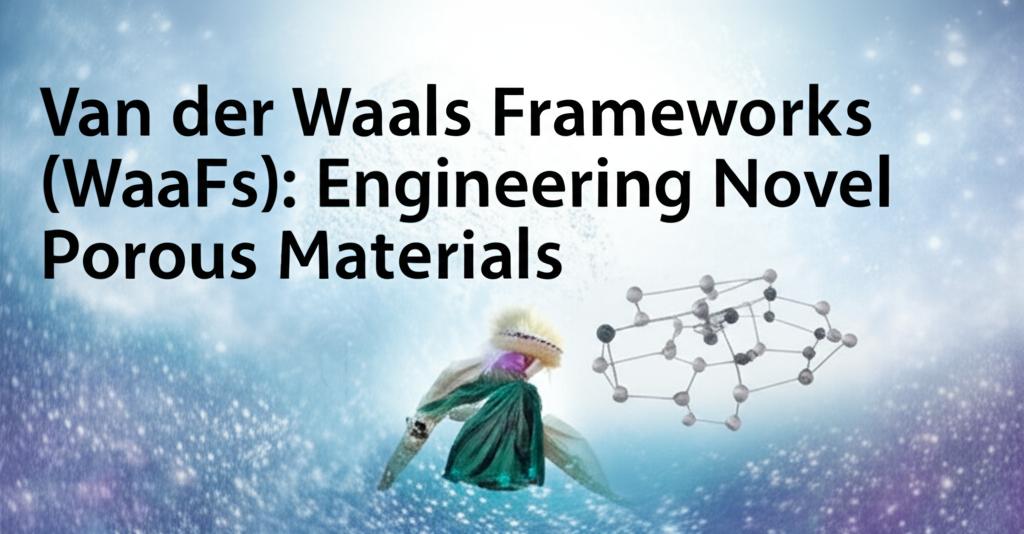Van der Waals Frameworks (WaaFs) represent a groundbreaking development in the field of porous materials, challenging previous assumptions about the limitations of van der Waals forces. These forces, traditionally considered too weak to form stable, open-framework structures, have now been ingeniously harnessed to create robust, highly porous, and thermally resilient materials.
A New Era in Porous Material DesignResearchers, notably from Kyoto University, have pioneered the development of the world's first three-dimensional van der Waals open frameworks. This was achieved by using octahedral metal-organic polyhedra (MOPs) as building blocks. These MOPs, typically larger than 2 nanometers, assemble into sparse diamond networks, creating significant extrinsic porosity. The key to their stability lies in the well-defined faces of these MOPs, which are composed of multiple planar moieties. This unique structure increases the intermolecular contact area, resulting in surprisingly strong van der Waals interaction energies, sometimes exceeding 400 kJ mol⁻¹. This is a significant finding, as interaction energies above 200 kJ mol⁻¹ are generally considered necessary for the synthesis of strong-bond open frameworks like Metal-Organic Frameworks (MOFs) and Covalent Organic Frameworks (COFs).
Exceptional Properties and Potential ApplicationsWaaFs exhibit a range of remarkable properties that make them highly promising for various industrial and technological applications:
- High Porosity: These frameworks can achieve impressive specific surface areas, in some cases exceeding 2,000 m²/g. This high porosity is crucial for applications involving adsorption and storage.
- Thermal Stability: WaaFs have demonstrated the ability to maintain their structural integrity at temperatures as high as 593 K (320 °C). This thermal resilience expands their applicability in processes that occur at elevated temperatures.
- Reversible Assembly: A unique characteristic of WaaFs is their ability to be disassembled and reassembled in solution. This feature is incredibly beneficial for scalability in production and for the recyclability of the materials, offering a more sustainable approach to advanced material manufacturing.
- Tunable Porosity and Chemical Stability: The inherent design of WaaFs allows for tunable porosity, meaning the size and distribution of pores can be controlled. Coupled with their chemical stability, this makes them adaptable for a wide range of uses.
These properties position WaaFs as strong candidates for applications in:
- Gas Storage and Separation: Their high surface area and tunable pores make them ideal for storing gases like hydrogen or methane, and for separating different gas mixtures, including carbon capture from industrial emissions.
- Catalysis: The porous structure can host catalytic sites, facilitating chemical reactions with high efficiency.
- Water Harvesting: The ability to adsorb and desorb molecules makes them potentially useful for capturing water vapor from the atmosphere, especially in arid regions.
- Molecular Sensing: Their defined pore structures could be engineered for selective detection of specific molecules.
The development of WaaFs signifies a paradigm shift in how chemists and material scientists view non-covalent interactions. While van der Waals forces are ubiquitous in molecular assemblies, their perceived weakness and lack of directionality historically limited their consideration for constructing permanent, porous solids. The success in creating stable WaaFs demonstrates that through careful supramolecular design – specifically by increasing the number of atoms involved in intermolecular contact to over 200 – these "weak" forces can indeed sum up to create strong and reliable "bonds" capable of supporting robust framework structures.
This breakthrough redefines the design principles of porous materials, showcasing a novel approach to material engineering. The scalability and recyclability offered by WaaFs are particularly significant, addressing key challenges in the practical implementation of advanced materials. As research in this area continues, WaaFs are poised to offer innovative solutions for a variety of global challenges, from clean energy storage to environmental remediation.

